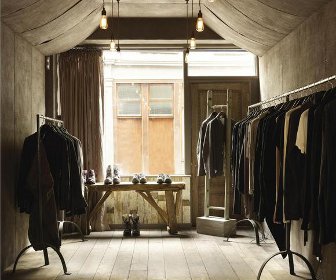Hostem men's fashion boutique, London
With Hessian Walls and Ceilings, bespoke fine detail and victorian floorboards, Jamesplumb has created a unique setting for men’s fashion boutique Hostem
Details
Project: Hostem
Client: James Brown
Design: Jamesplumb
Size: 4,230 sq m
Completion time: Two months
Size: 125 sq m
Project Description
Ensconced in the heart of London’s Shoreditch, men’s fashion boutique Hostem is anything but ‘high street’. Owner James Brown deals in high fashion by designers such as Rick Owens and Adam Kimmel, and he wanted a store whose interior mirrored the fine detail and exquisite quality of the clothes on sale. Brown brought in design duo James Russell and Hannah Plumb, whose company Jamesplumb he spotted at last year’s Tent London exhibition.
‘We were presenting some of our furniture pieces at Tent,’ says Russell, ‘but we also wanted to show an interior, so we made a sort of campaign tent.’ The tent was made of specially treated, hand-painted hessian, and Brown liked it so much that the same material ended up adorning the walls and ceilings of the Hostem store.
Russell and Plumb met at Wimbledon School of Art, where they studied fine art sculpture before moving into the design industry. They now live and work together in a cottage in the pretty conservation area of Stockwell Green, south London. The duo also sell some of their furniture pieces through the Jamesplumb website, although they aren’t too keen on being called product designers. ‘We still think of ourselves as artists, mainly,’ says Russell, ‘and we try to bring that approach to all our work, to treat it like an art installation.’
As the two show me around the store, it becomes clear what they mean. The attention to detail is staggering. ‘We get some strange looks sometimes when people see us adjusting things to within a fraction of an inch.’ says Russell. ‘But we really live and breathe it.’ The Victorian floorboards used throughout the store are a case in point. ‘We got the boards and loved them,’ says Plumb. ‘They had a really delicious kind of dusty quality [from plaster dust which had been trodden into the wood], which was wonderful, but not very practical if someone were to come in and put something down on them. We washed them and that made them look a bit too squeaky-clean, so then we aged them back with different paint washes to match the colours on the walls.’
From the cash desk, which is fashioned from an old church pew, to miniature plinths made from satchels filled with concrete for displaying footwear, on, nothing here is ‘off-the-peg’ (except the coat hangers, which Plumb assures me are only stand-ins for bespoke steel ones being made by metalworker and designer Alex Pole).
Plumb says: ‘We’d just started the job and we arrived carrying a church pew covered with rotten leaves. It raised a few eyebrows, I can tell you.’
Almost all of the furniture in the store is reclaimed or adapted from other objects, such as old wooden ladders set into concrete bases, used to display one or two stand-out garments at a time, low wooden trestles topped with raw concrete, and every door in the shop – nine in all – coming from the same salvage yard. Most of the lighting is from old-style American ‘trouble lights’, like those used by mechanics. The bulbs are housed in protective cages and they hang from the ceiling on painted silk flexes. A Jamesplumb-designed Cluster Chandelier, made from a bunch of vintage lampshades of different shapes and sizes, hangs from the ceiling above the reception desk. On close inspection you can see that each of the shades has been lined in a different fabric.
There are plenty of bold design statements in this scheme, such as the changing area, which is sectioned off from the rest of the store by several huge, ornate oak doors salvaged from a country house. But lesser designers might have compromised on the fine details, such as the bespoke clothing rails, whose bases metalworker Alex Pole painstakingly cold-bent around a cog he found in a river in Somerset. It sounds bizarre, but Plumb explains that it was the only way to attain the perfect curvature.
Hostem is Jamesplumb’s first commercial project, and the designers have approached it in the same way as they would their artwork, furniture pieces and residential interiors. ‘We didn’t really think of it as a shop-fit,’ says Plumb. ‘We’ve been really lucky because you have a close relationship with a client and it is really important that you all get on and trust each other, which is what happened on this project. I think that’s why it’s so strong.’
There were no mood boards or detailed plans on this project. Instead, Russell and Plumb allowed the space to develop naturally. ‘I love that way of working,’ says Plumb, ‘but some clients would probably go bananas.’
Main Suppliers:
Curtains:
• Beata Barton Chapelle
Decorative elements:
• Di Emme - www.diemme.com.au
Metalwork:
• Alex Pole - www.alexpoledesign.com;
Shop sign and artwork:
• Huw Griffith - www.colorset.co.uk This article was first published in FX Magazine.












